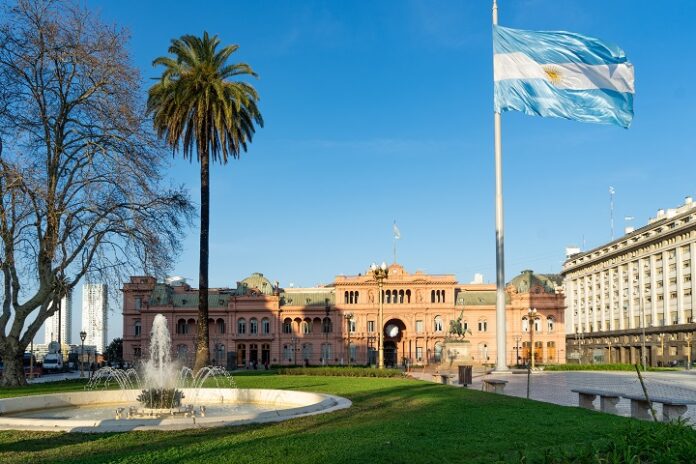Following his clear victory in the presidential election, the new president, Javier Milei, intends to push ahead with the liberalisation and deregulation of the economy. A decree and an omnibus bill containing just over 1,000 measures, including some very radical ones, are already being scrutinised in the National Congress of Argentina. These measures have been received rather favourably by the markets and the IMF. However, against a very tense political and social backdrop, the economy is plunging into stagflation and thecountry’s financial situation is still very precarious. The government has already discussed a reprofiling of domestic public debt repayments with the banks. A default on external debt could still be avoided with support from the IMF. However, if the recession continues beyond 2024, it is difficult to imagine Argentina emerging from the crisis without debt restructuring.
Javier Milei’s victory in the presidential election last October and the announcements of very radical economic policy measures since he took office on 10 December suggest a particularly difficult 2024 for the Argentine economy.
Shock therapy
Just a few days after he was sworn into office, the president signed a decree containing 366 changes aiming to stabilise the economy (the so-called “Necessity and Urgency Decree”, DNU), which has been in force since 29 December[1]. The stabilisation plan is mainly built around: 1) balancing the budget from 2024 through spending cuts of 2.9% and an increase in revenue of 2.2% of GDP and 2) devaluing the official exchange rate against the dollar from 376 to 800 pesos, combined with temporarily hiking import taxes (from 7.5% to 17.5%) and export taxes (with the introduction of a minimum rate of 15%).
On 20 December, President Milei tabled an “omnibus” bill containing 664 articles to the National Congress. These articles supplement the DNU, but are not urgent measures and instead have a much broader aim, focusing on mass privatisation, deregulating a number of sectors and easing labour market rules. Javier Milei has sought to delegate legislative powers to the executive for a renewable 2-year period, so that he could pass his measures without Congress’ approval.
The latest IMF review viewed the fiscal measures favourably, even though the devaluation of the peso will be accompanied by accelerating inflation. The country is expected to receive an additional USD 4.7 billion from the Fund before the end of January. The Argentine financial markets also reacted positively, as the spread between the official exchange rate and parallel exchange rates (blue-chip swap rate, MEP), which came down from 170% to 50% with the devaluation, has stabilised since the announcements. The Central Bank of Argentina’s foreign exchange reserves have increased by USD 4.8 billion since Milei took office.
Stagflation intensifies
However, the DNU has already been challenged on a number of occasions before the courts, with unions arguing that the measures are unconstitutional (particularly the labour market reform measures). At the same time, Milei would like to see the bill passed quickly by the National Congress, but his party does not have a majority in either the Chamber of Deputies or the Senate, and the support of small right-wing parties is not enough. Milei is locked in a very unpredictable stand-off with the deputies. Public hostility was also expressed through a general strike on 24 January. The political and social risk has therefore skyrocketed and is likely to reignite financial instability.
In the short term, the measures will lead to more severe stagflation than was anticipated before the elections. Industrial production and construction activity have been declining since 2022 and exports have been in freefall since 2023, as a result of the drought that has hit agricultural exports hard (see chart). Real GDP is expected to have fallen by an annual average of 2% in 2023.
Agricultural production should recover sharply in 2024, thanks to record harvests following several years of drought. However, in other sectors, the slump will simply deepen, following the inflationary shock of the devaluation of the peso.
Before the devaluation, inflation was already skyrocketing (+11% per month on average between August and November, compared to 7% between January and July), despite price-increase controls introduced by the previous government. In December, inflation came in at 25.5% over one month and 211.4% over one year, with the devaluation and the end of price controls triggering a catch-up wave, particularly around fuel prices (+47.7% over one month) and food prices (+29.7% over one month).
Inflation will remain very high during the first half of 2024 as the catch-up will continue (according to JP Morgan’s calculations, so far only 30% of the monetary devaluation has been passed on) and regulated prices, which account for 16% of the consumer basket, will rise sharply as a result of the subsidy cuts. The monthly inflation rate is forecasted to average about 15%-20%. In the second half of 2024, if the depreciation of the exchange rate is contained at 2% per month (official target), inflation could fall below 10%. However, this can only happen if money-based inflation disappears. Therefore, much will depend on the credibility of the budgetary targets, on whether these targets are met and on the replenishment of foreign exchange reserves.
New public debt restructuring on the horizon ?
The government’s financial situation is still precarious. For 2023 as a whole, the new administration is forecasting a primary deficit of 3% of GDP, which is a rise of 1 point of GDP compared to 2022. In view of the interest burden of 2.2%, the total deficit is expected to stand at 5.2% of GDP.
However, according to calculations by GlobalSource Partners, the Central Bank of Argentina (BCRA) saw its own interest burden double to almost 9% of GDP in 2023, pushing the public deficit up to 14% of GDP. As a matter of fact, the direct (advances to the Treasury) and indirect (purchases of government securities) monetary financing of the budget deficit forced the BCRA to issue sterilisation bonds (28-day LELIQ) amounting to up to an equivalent of 8% of GDP, at an interest rate that rose from 75% at the end of 2022 to 133% until 18 December[2]. Reducing the BCRA’s liabilities is a government priority. Since November, LELIQS, whose stock only accounted for 1% of GDP at the end of December, have no longer been issued and have been replaced by reverse repos. At the same time, the key policy rate was lowered to 100%. Nevertheless, the interest burden for the BCRA will remain very high.
Even if the government manages to balance its books and contain the debt burden which has spilled over into the BCRA debt burden, it will face a liquidity problem on both domestic and external debt.
Repayments of domestic debt denominated in pesos (including debt indexed on inflation and the exchange rate) represent the equivalent of USD 35 billion. Fortunately, 65% of this debt is held by government-owned banks. Therefore, a meeting was organised at the start of January, at the behest of the Economy Minister and the Secretary of Finance, with representatives from the major banks to discuss postponing the 2024 repayment deadlines. It should be noted that the previous Economy Minister Sergio Massa had already imposed a postponement of the 2023 repayment deadlines on banks, at the end of 2022.
External debt repayments (interest and principal) amount to USD 16.8 billion for 2024 (USD 7.5 billion for the IMF, USD 5 billion for other official creditors and USD 4.3 billion for private creditors), with two significant falls in January and July. In addition to this, there is also the trade debt accumulated by importers to their suppliers in 2023 because they were unable to obtain dollars. This debt was valued at USD 21 billion at the end of 2023.
The payment of USD 4.3 billion by the IMF should cover the debts falling due in January 2024. However, foreign exchange reserves only amount to USD 24 billion and are even negative in net terms (i.e. minus the banks’ reserve requirements and the swap line with the Central Bank of the People’s Republic of China). In addition, the Argentine government has been ordered to pay compensation of USD 16.1 billion to creditors adversely affected during the nationalisation of the oil company YPF in 2012.
As things stand, international debt issuance is not an option. The government is being forced to issue domestic bonds denominated in dollars to settle importers’ commercial debt[3]. However, demand is low as the interest rate offered (5%) does not remotely cover the risk.
At the end of December 2023, federal government debt stood at USD 368 billion, including USD 264 billion in foreign currency (mostly in dollars). Following the December devaluation, the debt ratio is equivalent to 154% of GDP[4] and foreign exchange reserves only cover one tenth of the foreign currency debt. It seems inevitable that domestic public debt repayments in 2024 will have to be reprofiled. With the support of the IMF, the government could still avoid defaulting on its external debt. However, if the recession continues beyond 2024, it is difficult to imagine Argentina emerging from the crisis without debt restructuring.
Article completed on February the 2nd 2024
Source link





